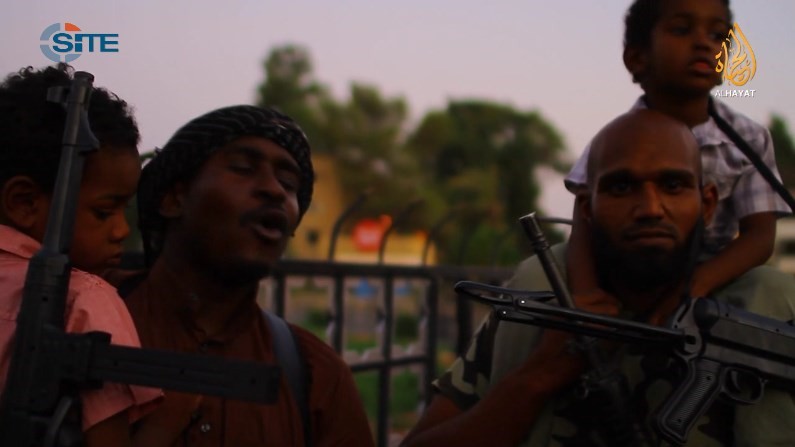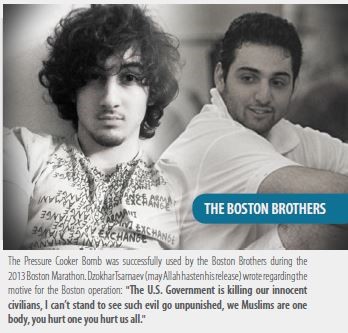Digital Passageway: The Jihadist Propaganda Machine Aims West

Douglas McAuthur McCain, the American Islamic State (IS) fighter recently killed in Syria, is yet another story of an American turning to jihad in recent years. Meanwhile, officials indicated that the number of Americans who left to fight in Syria has doubled since January 2014, and while Washington and other Western countries continue to “discuss” plans on how to counter domestic, al-Qaeda (AQ) and the Islamic State (IS) have successfully brought the jihadist movement into Western homes more effectively than ever before.
The case of McCain and others like him echoes a disquieting question: What is making Westerners flock to jihad?

We can’t get inside of McCain’s head, nor that of Moner Mohammad Abu Salha (AKA Abu Hurayra), an American citizen who performed a suicide mission in Syria, nor Donald Ray Morgan’s (Abu Omar al-Amriki), an alleged American jihadist recently arrested at JFK Airport. However, what attracts Westerners to join the IS or al-Qaeda (AQ) can be better understood by looking to the thriving jihadist recruitment campaigns that AQ and the IS are bringing into Western society and homes more effectively than ever before.
Online recruitment approaches have reaped significant results for jihadist groups as thousands of Western jihadists currently fight in Syria and Iraq. American, Canadian, British, German, French, and Australian militants— just to name a few—are fighting alongside AQ and the IS, happy to sacrifice their lives for jihad. Much of these fighters’ presence in Syria can be attributed to recruitment campaigns launched through social media.
Groups like the IS, al-Nusra Front, the Shabaab al-Mujahideen Movement in Somalia, and al-Qaeda in the Arabian Peninsula (AQAP) have invested much of their energy into special media groups dedicated to creating such propaganda. And, since the beginning of the Syrian Civil War, jihadist groups—most notably the IS—have been generating recruitment material at a rapid pace and distributing it across an array of social media platforms.
The IS, moreso than any other jihadi group, invests a tremendous amount of its efforts and resources into recruiting supporters from the West, as is evident by the fact that it has created a media group dedicated to creating propaganda in Western languages, mainly in English. This group, “al-Hayat Media Center,” regularly releases, among other materials, exalting video profiles of jihadist fighters calling for all Muslims to join jihadist efforts in Syria.
In July alone, al-Hayat distributed eleven releases in English, including high-definition video profiles of Western fighters, speeches, and magazines. That’s a new release every three days—from just one group.
In July alone, al-Hayat distributed eleven releases in English, including high-definition video profiles of Western fighters, speeches, and magazines. That’s a new release every three days—from just one group. While the media group didn’t produce as many releases in August, it did make up for the lower quantity with its shocking release of James Foley’s beheading video —a release that prompted a giant swell of jihadist chest-pumping on social media.
What jumps out most about this propaganda is the production quality of their videos—displaying high-definition pictures, proficient editing, and consistent branding of their respective groups. Productions by al-Hayat and other jihadist media groups hold up to the same quality of the mainstream content that viewers regularly watch on television or the internet.
Though Salha is dead, jihadi groups have managed to keep him alive by continually flooding the internet with images, videos, and statements by him.
For example, fighters like Moner Mohammad Abu Salha, the aforementioned American suicide bomber in Syria, have been a recruitment goldmine for the al-Nusra Front and other AQ-affiliated groups. Though Salha is dead, jihadi groups have managed to keep him alive by continually flooding the internet with images, videos, and statements by him. On July 25, al-Nusra Front’s “al-Manara al-Baydha’ Media Foundation” released a video of a previously reported suicide attack in Idlib from May 25 of this year involving Salha. Just three days later, the Global Islamic Media Front (GIMF), an AQ-linked media organization, released their own 17-minute posthumous video of Salha titled “The Story of the American Muhajir.” The GIMF video, converse to the al-Manara al-Baydha’ version, features him speaking in English. Salha expresses:
I lived in America. I know how it is. You have all of fancy amusement parks and the restaurants and the food and all this crap and the cars. You think you're happy? You're not happy, you're never happy. I was never happy. I was always sad and depressed.

This recurring subject of angst and not fitting in as linked to living in the West may speak simultaneously to jihadists’ target audience and, subsequently, their points of appeal toward young Western fighters. In a video released by al-Hayat on June 19, titled “There is No Life Without Jihad,” a group of fighters sit next to each other—each claiming to be British or Australian. One of the fighters, identifying as “Abu Muthanna,” makes a similar appeal as Salha:
I know how you feel. I used to live there. In the heart you feel depressed. The Messenger of Allah, Allah's peace and blessings be upon him, said: The cure for depression is jihad in the cause of Allah. You feel like you have no honor, but the Messenger of Allah, Allah's peace and blessings be upon him, said: The honor of a believer is come with light, the honor of the Ummah is jihad in the cause of Allah.

In more recent videos, the IS has tried to reach even further into the West—beyond potentially alienated Muslims who might only need a small bit of persuasion to join jihad. On July 11, al-Hayat released a posthumous video of a Canadian jihadist in Syria identifying as “Abu Muslim.” The video, which is also accompanied by an English-speaking narrator, starts off with Abu Muslim’s unabashed appeal to all Muslims as he describes his traditional Western upbringing:
Before Islam, I was like any regular Canadian: I watched hockey, I went to the cottage in the summertime, I loved to fish, I wanted to go hunting, I liked outdoors, I liked sports. I was like your everyday, regular Canadian before Islam. Then, [praise be to Allah], Allah [the Great and Almighty] guided me from the darkness of kufr [disbelief] to the light of iman [faith], to Islam.
The fighter further explains that “mujahideen are regular people” and then makes a push at idle Muslims, claiming that they “can’t live as a Muslim” in the West, and that the act of living there is contributing to “their war on Islam.”
Once the “Caliphate” was announced by the IS on June 30, 2014, al-Hayat has been very successful in releasing even more inspirational videos, featuring fighters from Europe, North Africa, South Africa, Southeast Asia, and the United States promoting jihad and the “Caliphate”.
IS further initiated an aggressive campaign in English through al-Hayat, urging Muslims to fulfull their “duty” to make emigrate to the “Caliphate”, and even provided instructions how and what is needed. For instance, the second issue of its English magazine “Dabiq,” released on July 27, 2014, the IS ugred:
Many readers are probably asking about their obligations towards the Khilāfah right now. Therefore the Dābiq team wants to convey the position of the Islamic State leadership on this important matter.
The first priority is to perform hijrah [migration] from wherever you are to the Islamic State, from dārul-kufr [the land of infidals] to dārul-Islām [land of Islam]. Rush to perform it as Mūsā (‘alayhis-salām) rushed to his Lord, saying, {And I hastened to You, my Lord, that You be pleased} [Tāhā: 84].
Rush to the shade of the Islamic State with your parents, siblings, spouses, and children. There are homes here for you and your families. You can be a major contributor towards the liberation of Makkah, Madīnah, and al-Quds. Would you not like to reach Judgment Day with these grand deeds in your scales.
The IS reiterated these calls in the third issue of “Dabiq”, which was released on social media on August 29, 2014, and gave advice for those "embarking upon Hijrah," writing:
Do not worry about money or accommodations for yourself and your family. There are plenty of homes and resources to cover you and your family.
The same calls were also promoted through the group's video releases. One particularly inspiring and extraordinary video produced and released by al-Hayat is “Eid [Holiday] Greetings from the Land of Khilafah,” which it posted on its account on the social networking website Diaspora on August 2, 2014—just five days after its recording. The 21 minute video, features the great life for Muslims under IS, for families, individuals, fighters, and Muslims in general. Segments with a variety of foreign fighters from countries including Belgium, Britain, Finland, Indonesia, Morocco, South Africa, Tunisia, and the U.S. In the video, some call Muslims to come with their families and experience the Shariah-based governance under IS rule, and others tell Muslims to fight in its ranks. Many of these segments show the fighters with children as they call on their friends and families.
A 20 minute, 52 second video, for example, entitled “Eid [Holiday] Greetings from the Land of Khilafah,” was posted on al-Hayat’s account on the social networking website Diaspora on August 2, 2014—just five days after its recording. Footage from the video features segments with a variety of foreign fighters from countries including Belgium, Britain, Finland, Indonesia, Morocco, South Africa, Tunisia, and the U.S. In the video, some call Muslims to come with their families and experience the Shariah-based governance under IS rule, and others tell Muslims to fight in its ranks. Many of these segments show the fighters with children as they call on their friends and families.

In this video, a fighter from America (originally from Trinidad) is identified as Abu Abdurahman al-Trinidadi. Standing with a child and a gun in his arms, he urges Muslims to come to Syria and participate in jihad, stating that he feels like he is “still dreaming” and that one would “would have to be here to understand” the feeling. To a more chillingly direct note, he follows up, “Who can make it, come. Come to Sham as soon as possible. Do not make the Shaytan [Satan] hold you back.”
In their own testimonials, Western jihadists have repeatedly indicated that such propaganda has played a vital role in their radicalization.
In their own testimonials, Western jihadists have repeatedly indicated that such propaganda has played a vital role in their radicalization. In the GIMF-released video of Salha, he refers to a video he saw of a Russian woman who carried out a “martyr operation in Afghanistan and Pakistan” four years after her husband was killed by the Pakistani army. Of the video, he claims, “This video that I watched from the sister inspired me and touched me.”
Many other Western jihadists have also claimed to be moved by jihadist material—and not just videos. The April 2013 Boston Marathon attack, carried out by Tamerlan and Dzhokhar Tsarnaev, were inspired by jihadi propaganda. Not only did Tamerlan Tsarnaev's YouTube account “favorite” jihadi videos, but his attack was also inspired by and followed directions provided in jihadi publications—particularly the long-standing AQAP publication, “Inspire.” Chillingly, in their issue following the attack, “Inspire” editor Yahya Ibrahim stated, “Yes, the brothers have been inspired by Inspire. This is not only because Inspire offers bomb recipes, but also because of the contents of the magazine as a whole.” More, Dzhokhar Tsarnaev’s indictment also stated such propaganda was an inspiration for him.

Yet, while jihadi recruitment always had an important role in global jihad, there was a step change with the jihadists' adaptation of Twitter and other social media to recruit, incite and intimidate. The content produced by these media groups quickly trickles down to a grassroots level of dissemination, where jihadist fighters and supporters share, post, and retweet the content on their social media accounts. IS, in particular, has acknowledged the importance of this method of distributing their material. In the last two months alone, IS media groups have held accounts on Twitter, Facebook, to Friendica, Quitter, and Diaspora among others to harness such support.
A tweet by McCain, the previously mentioned American IS fighter recently killed in Syria, shows one example of such dispersal methods. On April 3 of this year, the transcript of a speech by IS spokesman Abu Muhammad al-‘Adnani, titled “And That He will Grant Them the Authority to Practice their Religion which He has Chosen for Them,” was produced by the group’s “al-Furqan Media Foundation” and posted to jihadist forums. That day, prominent Australian jihadist recruiter Musa Cerantonio translated the speech and tweeted a link to it. Then, McCain and 33 other jihadists also retweeted the translation to other English speakers, with which they could further retweet it and receive Adnani’s message, wherein he states that “democracy is nothing but a tool and method by which the Ṭawāghīt [tyrants] are empowered and by which they wage war upon the Religion of Allah.”
The spatial barriers that once separated the West from jihadist threats have been largely diminished by new waves of recruitment media. As this jihadist content is produced and distributed across the borderless terrain of social media, what was once over there begins to feel alarmingly close. Such releases may not give-off a building-wrecking explosion, but they are, increasingly so, the devices that initiate them. Understanding and responding to these barrages of recruitment material may be our first step in understanding why Westerners are leaving for jihad.

